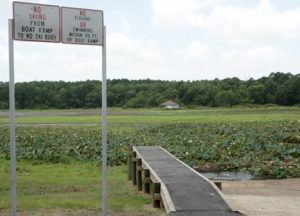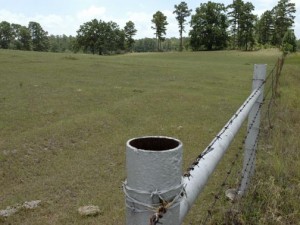COLLEGE STATION Some parts of Texas received much needed rain this week; other parts went begging, reported county agents with Texas Cooperative Extension.

Eastern Texas received some rain last week, but many ponds, lakes and reservoirs, such as Lake Tyler East, remain critically low. (Texas Cooperative Extension photo by Robert Burns)
“We finally got rain where we needed it; most of the planting is done,” said Kyle Stewart, Extension agent for agriculture in Armstrong County.
A few producers were still trying to finish up some spots and replant, and some cotton failed and was replanted as well, Stewart noted.

Some parts of East Texas received as much as 4 inches of rain during the week, but many pastures, such as this one in Smith County, remain stressed. (Texas Cooperative Extension photo by Robert Burns)
“We still need more moisture, however, at the subsoil (level),” he said.
“Recent rains have helped the area tremendously,” said Justin Scott, Extension agent for agriculture in Cochran County.
“While the rain has been sporadic, it has been generally widespread with local heavier amounts,” he said.
Burton Williams, Extension agent for agriculture in Hansford County, reported, “Parts of Hansford County received rain last week, but pastures remain ‘extremely’ dry. What little dryland crops were planted never emerged. … (There were) reports of up to 2 inches; other parts of the county nothing.”
In Dawson County, however, severe drought conditions persisted, said Jeff Wyatt, Extension agent for agriculture.
“North of Lamesa, dryland crops are non-existent,” Wyatt said. “Irrigated crops continue to show signs of stress. … Precipitation is needed soon for any chance of a good crop for Dawson County.”
A somewhat gloomy picture held true for Glasscock County too, said Rebel Royall, Extension agent for agriculture.
With drought conditions persisting, “none of the dryland cotton emerged and has been ‘disastered out’,” Royall said.
“Disastered out” refers to the U.S. Department of Agriculture’s Crop Disaster Program. Under the program, crops become eligible for disaster payments if crops cannot be planted or production is drastically reduced by adverse weather or natural disasters.
“Drought conditions continue in Wilbarger County. (There’s) not much to report except for dry weather with milder temperatures this past week compared to previous week,” said Langdon Reagan, Extension agent for agriculture based in Vernon.
“Cattle herds continue to be sold off due to lack of forage and water. Pray for rain!” Reagan said.
Extension officials reported the following conditions for the week:
PANHANDLE: Temperatures were near or below normal during the week. Rain occurred over several days. Rain amounts ranged from a trace to isolated reports of 2 to 3 ½ inches. Soil moisture is rated short to very short.
Corn is rated poor to good with most areas reporting fair. Irrigation is heavy. Spider mite infestations continue to be reported. Western corn rootworm beetles are emerging.
SOUTH PLAINS: From a half to more than an inch of rain was received early in the week. Cooler weather has allowed crops to look somewhat better. Soil moisture is short to very short. Cotton is in fair condition. Cotton under center pivot continues to look good, and insect pressure remains low. Primary field activities include irrigation, fertilizing and Roundup applications on RR Flex fields. Dryland cotton is in very poor condition. Corn is in good to excellent condition. Irrigated corn is progressing well, though center pivots have been running nonstop. Peanuts are in fair to good condition and are growing well. Irrigated sorghum is in fair to good condition. Dryland sorghum acres are burning up. Pumpkins are progressing well. Pastures and ranges are in very poor to poor condition. Cattle conditions are mostly good. Supplemental feeding is necessary for all grazed livestock.
ROLLING PLAINS: Drought conditions continue across the region. Cotton is suffering and dying in the fields due to lack of moisture and subsoil moisture. Unless some counties receive rain in the next week to10 days, producers will begin to abandon dryland cotton fields. Producers are seeing some insect damage in cotton. Stocker cattle are nearly all shipped out of the district to feedlots. Cow/calf herds are being heavily supplemented as there is no new growth in pastures or rangelands. Wheat fields have had or are having their first plowing since harvest in preparation for next year’s planting.
NORTH: Soil moisture remains very short in some areas. Scattered thunderstorms dropped as much as 2 inches of rain in some parts of the region. Much more rain is needed to return soil moisture to normal levels and replenish ponds and lakes. Crop conditions have worsened due to moisture stress. Farmers do not think recent rains will have much of an impact on crop conditions. Corn is being harvested for silage, and soybeans are being baled for hay rather than going to grain. Cattle are being sold, and hay supplies are looking bleak for this fall. Sorghum ranges from poor to fair condition. Some dairymen have irrigated sorghum that looks good. Winter wheat and oats have mostly been harvested. Cotton on heavy soils is holding on but cotton on the lighter soils is under severe stress. Range and pasture condition ranges from poor to very poor. Grasshopper numbers are on the rise.
EAST: As much as 4 inches of rain reported in some areas. Overall soil moisture remains seriously low, however. Areas that received measurable rainfall report improved conditions, which should improve hay production as well as grazing. Hay supplies and hay harvests continue to be short. Some reports of producers buying hay from out of state. Calf markets still good; cow market has fallen sharply. Reports of livestock being sold due to shortage of forage production. Stock water supplies short in some areas. Vegetable gardens are suffering from drought conditions. Watermelon, blueberry and tomato harvests continue in Smith County.
FAR WEST: Soil moisture ranges from very short to adequate, and crops and pastures are in very poor to good conditions. Cotton is in good condition with as much as 90 percent squared and bolls set from 3 percent to 75 percent. Winter wheat is 100 percent harvested. Widely scattered showers in the area this week. Not much precipitation, but what little was received helped tremendously.
WEST CENTRAL: Continued hot-dry weather conditions. Temperatures remain in mid to upper 90s. Scattered showers reported in a few areas. Most areas are extremely dry. Fire dangers are high. Most small grain harvesting is complete. Some cotton is starting to show effects of moisture stress. In areas that have received rainfall, cotton crops are doing very well. Sorghum is in fair to poor shape due to drought. Some small grain fields are being plowed under. Corn is maturing and will be harvested soon. Cutting and baling hay fields continues in some areas. Producers are concerned with prussic acid and nitrates. Range and pastures in some areas are showing some improvement after recent rainfall. Stock tanks are drying out fast and are in danger of oxygen depletion and fish die-off. Livestock are in adequate body shape. Feeding and culling of livestock continues. The pecan crop is marginal to spotted and is “way off” from normal.
CENTRAL: Except for irrigated operations, continued drought has almost stopped agricultural operations in some parts of the district. Pastures have shown signs of improvement where rain was received. More, however, is needed. Cattle are still maintaining body conditioning well. Most of the corn acreage has been made into silage. Remaining acreage ranges from excellent to poor in yield potential. Grazing and hay supplies are short. Several producers are weaning calves to cut down on stocking rates.
SOUTHEAST: The area received substantial rains, which improved all agricultural conditions. Producers took advantage of the rain by applying more fertilizer. Peanuts were planted; melons and other truck crops were being harvested. Peaches are also available for fresh market. Producers continue to apply herbicides on hay meadows and pastures for weed control. Farm ponds have experienced fish die-offs due to low oxygen caused by cloudy and cool days. Cattle marketing has slowed down with the recent rain. Rain is hindering hay harvest. No issues arose this week, except rain, which delayed grain sorghum harvest. Hay baling was delayed and should resume during the middle to the end of the week. Livestock are doing well.
SOUTHWEST: Except for very few local areas which received 1 or more inches of much needed rainfall during the first few days in July, most of the southwest Texas region remains very dry. The year-to-date cumulative rainfall is less than 30 percent of the long-term average for the same period. Except for small areas which received some rain in June and early July, forage availability is almost completely depleted in more than 50 percent of the region. Cotton and peanuts are making good progress under heavy irrigation. The corn and sorghum harvest is just starting to gain momentum. Corn, cotton and sorghum production under dryland conditions will be down 70 percent to 80 percent due to the drought. The watermelon and cantaloupe harvest continues but is starting to wind down. The onion, potato and green bean harvests are complete. Pecan orchards are showing signs of drought stress and are starting to drop pecans.
COASTAL BEND: The most beneficial week of rainfall in over a year occurred this past week. Most areas are still as much as 12-14 inches below normal rainfall during the past 12 months and are still in a drought situation. Rains have halted grain sorghum harvest. The rain came too late for any major improvement in most early planted crops. Rangeland and pastures will respond to rain, producing good summer forages in the next couple of weeks. Livestock numbers, however, are expected to remain low as ranchers allow forage time to recover before restocking.
SOUTH: Soil moisture short to adequate. Scattered rains this week brought some drought relief to some areas. It will help some cotton and hurt other cotton. Early cotton defoliation will begin next week. Onion, watermelon and cantaloupe harvest has been completed. Supplemental feeding continued. Range and pasture conditions improved in areas that received good rains the last few weeks. Hay baling was halted temporarily this week.
-30-


